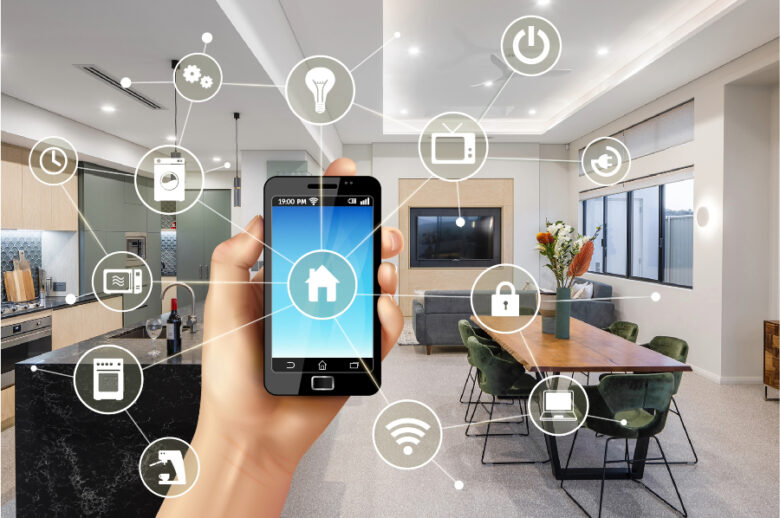Imagine walking into your home and having Aria, your voice assistant, welcome you with an inviting pre-programmed routine: lights slowly dim to match your desired ambiance, music starts playing softly on your smart speaker, and coffee begins brewing! Smart home systems powered by AI can adapt and learn from user behavior to provide seamless experiences that provide seamless intelligence.
1. Energy Management
Smart home devices monitor energy use to gain insight into user behaviors, anticipate needs, and optimize systems. For instance, a smart thermostat monitors family schedules to adjust heating and cooling systems based on occupancy, saving energy without compromising comfort.
Companies such as LG are using AI chips on-device to process large volumes of data in real time, recognizing environmental changes and optimizing appliance performance. Furthermore, smart appliances can easily be accessed and controlled with voice commands or mobile apps for maximum convenience and efficiency. Builders are adding advanced features into new homes to appeal to tech-savvy buyers, such as Lennar’s Everything’s Included program that equips homes with smart home technology like Ring video doorbells, Schlage Encode locks, and Amazon Alexa devices.
2. Home Security
Home security systems have evolved considerably thanks to AI technology. AI-powered cameras can distinguish faces, identify suspicious behaviors, and provide real-time alerts for homeowners. Similar to smart water management systems like the Flo by Moen, smart thermostats learn residents’ habits to optimize energy usage and minimize waste. They also feature artificial intelligence for leak detection.
These innovations have created a new breed of homes that are safer, smarter, and more responsive to their owners. Real estate companies are taking notice and are beginning to integrate advanced technologies into their offerings to draw in tech-savvy buyers who prioritize sustainability and convenience.
3. Entertainment
AI’s entertainment applications are just beginning to emerge, with voice assistants becoming capable of understanding intent and answering queries such as who’s on TV or which movies are playing. Narrow AI can be found in many daily products, ranging from virtual assistants like Siri and Alexa to recommendation engines on streaming platforms like Netflix and Spotify. Generative AI skills have become an in-demand skill among tech professionals.
Large companies are increasingly turning to artificial intelligence (AI) solutions to solve big problems and make life more efficient for their customers. Uber uses its AI system to analyze traffic and weather conditions so riders can receive estimated arrival times (ETA) and set fare rates accordingly.
4. Communication
With AI as their central hub, different systems and devices can interact efficiently to allow residents to manage all aspects of their home with just a voice command or app interface. Smart cameras with facial recognition technology can recognize family members and distinguish them from strangers, reducing false alarms. Furthermore, these smart cameras can detect suspicious activities like tampering and notify homeowners quickly for faster responses.
Real estate companies such as Lennar integrate smart technologies into their new homes to appeal to tech-savvy buyers, such as through the “Everything’s Included” program, which features intelligent features to make everyday living simpler and more energy efficient. Other examples of smart home technology include thermostats, leak detection systems, and wellness solutions from Delos.
5. Automation
Automation is an aspect of artificial intelligence that allows devices and systems to function without human input, such as autonomous vehicles and drones. Companies like Tesla and BMW employ robots in their Gigafactories for assembly purposes, increasing productivity while upholding quality standards.
Smart home systems employ automation to streamline operations and personalize user experiences. For example, smart thermostats use automation to adapt settings according to a homeowner’s schedule to reduce energy use without compromising comfort, while lighting adjustments based on natural light levels or occupancy may save energy while creating the ideal atmosphere for reading or relaxing.
6. Virtual Assistants
Artificial intelligence powers virtual assistants that help users manage their calendars, to-do lists, and reminders – making tasks like grocery shopping more manageable than ever! Furthermore, these virtual assistants can control a range of smart devices, including lights, locks, thermostats, and doorbell cameras – and they even help manage lights, locks, and thermostats!
Automation systems learn and remember user preferences in order to provide tailored responses, as well as detect contextual cues for automated tasks, improving efficiency and convenience for the user experience. Concerns remain regarding interpretability and algorithmic bias; further research into strategies to combat such practices while encouraging ethical AI technologies must continue.
7. Personalized Experience
Smart homes that utilize AI can interact with users directly to provide an experience tailored to meet their unique needs and preferences. AI technology can recognize user behaviors and activate automated actions for comfort, convenience, and security improvement.
Voice assistants like Aria could, for instance, recognize your arrival home and initiate a pre-programmed “Welcome Home” routine that dims the lights and plays your preferred playlist to create an inviting and comfortable environment. Aria could even coordinate with other smart devices to optimize energy management and ensure safety and sync up with wearable devices for optimizing lighting and temperature adjustments that promote well-being.
8. Connectivity
AI is making smart homes an integrated ecosystem, where devices communicate seamlessly between themselves and with users. AI voice assistants enable users to control all of their connected devices using natural language commands, simplifying interaction while decreasing barriers for accessibility for people of all ages and abilities.
Smart home systems equipped with AI can learn and anticipate user needs; for instance, if a family usually wakes up around 7 AM, their thermostat will adjust the temperature and turn on lights and the radio prior to them waking up, thus saving energy while increasing comfort levels.
9. Immersive Experience
Immersive experiences differ from conventional ones by employing visual, auditory, and tactile stimulation to immerse participants fully in an experience that leaves an imprint and lasting memory of its own. This multisensory interaction heightens the impact and memorability of an experience.
Immersive experiences provide users with an enhanced sense of spatial presence by making them feel as if they’re physically situated within a virtual environment, making for an exceptional user experience. Immersion plays an integral part in providing this overall sensational adventure! An immersive experience can offer users an escape from reality, introduce them to new viewpoints, or expand beyond what would normally be possible. But for an optimal immersive experience to truly be effective, it must not simply entertain; rather, it should leave lasting traces.




